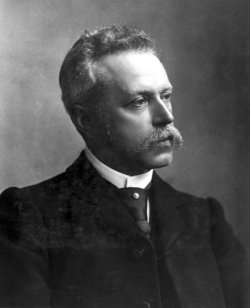John Kemp Starley (24 December 1855 – 29 October 1901) was a founder of what became the Rover car manufacturing company and inventor of the safety bicycle, a claim he shared with several other contemporary bicycle manufacturers. The design of his Rover safety bicycle was, however, undoubtedly the best on the market,[1] and it soon “prevailed as the universal bicycle style”.[2]
Starley was born in Walthamstow, Essex, the son of John Starley, a market gardener, and his wife, Mary Ann Cippen. His drawings of a steam engine, done while still a teenager, so impressed his uncle, the inventor and cycle maker James Starley, that in 1872 James offered to train him in Coventry.[1]
Starley moved on to cycle makers Haynes and Jeffries (later Rudge) in 1877, and the following year founded his own cycle manufacturing company in Coventry, J. K. Starley & Co., in partnership with William Sutton, a local haberdasher.[1]
Bicycle manufacturing
Starley’s first and most commercially successful product was the Rover safety cycle, a rear-wheel-drive, chain-driven bicycle with two similar-sized wheels, making it more stable than the previous high-wheeler penny-farthing designs with their huge front wheels, known at the time as the “Ordinary”. With its sloping front forks, adjustable seat, handlebars, crankshaft and pedals, it was the first of the earliest recognisably modern bicycles.[1] Initially met with ridicule by those who had become accustomed to the penny-farthing designs, within a few years it had completely supplanted them.[3]
Less successful was Starley’s electric tricar, which he tested in 1888 in France, to avoid the restrictions of the 1878 Red Flag ActThe Locomotive Acts of 1861, 1865 and 1878 set the United Kingdom's first speed limits for road-going vehicles; powered passenger vehicles were at the time known as light locomotives, as they were invariably powered by steam.. J. K. Starley & Co. was floated as the Rover Cycle Company in 1896, earning Starley £100,000, but he retained 20 per cent of the ordinary shares and remained as managing director of the new company. The bicycle boom came to an end in 1896, and by 1898 many of Coventry’s bicycle manufacturers had gone into receivership. Right to the end of his life, Starley resisted any plans for Rover to experiment with motor-car production, but following his death in 1901 the company almost immediately began to manufacture motor cycles, and by 1912 Rover had abandoned its by then loss-making bicycle business altogether and moved into car manufacturing.[1]
Personal life
Starley married nineteen-year-old Abigail Statham in 1876, and together they had six sons and four daughters. Their eldest son, also named John Kemp Starley, eventually became managing director of the Rover Company set up by his father.[1]
Between 1890 and 1896 Starley was a Liberal member of Coventry council. He had a deep if not always orthodox religious conviction, and believed in the spiritual priority of the New Testament over the Old to the extent that he produced his own version of the Bible, the “Starley Bible”, in which the conventional order of the two is reversed. Among his philanthropic endeavours was his support for the Coventry YMCA and the Salvation Army.[1]
On 29 October 1901 Starley died at his home, Barrs Hill House, in Radford Road, Coventry, from complications caused by untreated gall stones;[a]Starley’s heart was considered too weak to withstand an operation.[1] an estimated 20,000 people attended his funeral, such was his popularity. By the time of his death Starley had registered eighty-seven patents in his own name.[1]


